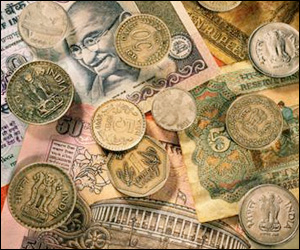|

The government has taken many steps to contain the free fall of rupee in the past few days but has failed to check the slide. Slumping further, the rupee tested new record low of 68.75 versus the US dollar.
Reserve Bank of India’s (RBI’s) recent intervention did precious little to save rupee from depreciating further. India's currency has lost over 19 percent against the dollar this year.
In order to arrest the rupee slide, RBI had announced measures such as restriction on Indian firms investing abroad and on outward remittances by resident Indians, triggering talks of return of capital control regime.
At the Interbank Foreign Exchange (Forex) market, the rupee on Wednesday fell past 68 mark to trade at fresh low of 68.75 against dollar.
What are the reasons that have impeded the efforts of the government in tackling rupee fall? Why can’t the government check the depreciation of rupee? Why have even RBI measures aimed at tightening liquidity failed to give a boost to the staggering rupee? These are a few questions that continue to crop up every time rupee crashes to newer lows.
Worsening current account deficit
High Current Account Deficit (CAD) is the main reason that has continuously impeded all efforts of government in arrest the fall of rupee. India posted a record current account deficit of 4.8 percent of gross domestic product (GDP) in the year ending March. Government’s failure to explore new destinations has led to poor growth of exports. In the absence of a single window clearance system and process delays, exports have failed to register good growth. Even traditional export areas have failed to show resilience making Indian produce globally less competitive.
Insufficient FDI inflows
Despite all the decisions to allow major reforms in India, the government has failed to tap major FDI inflow in the country. Instead, India has witnessed withdrawal of major projects by global giants like ArcelorMittal and Posco. Posco pulled out of its Rs 30,000 crore steel plant project in Karnataka followed by ArcelorMittal that scrapped its USD 12 billion (Rs 50,000 crore) steel plant project which it was planning to set up in Odisha. Inordinate delays, land acquisition problems, government clearance delays, lack of promptness have all contributed to the withdrawal of major companies. Last year Indian companies spent more overseas than Foreign Investors in India.
FII outflows
Overseas investors have pulled out nearly Rs 18,500 crore (about USD 3 billion) from the Indian capital markets in July. In their highest monthly outflow, overseas investors pulled out a record Rs 44,162 crore (over USD 7.5 billion) in the month of June. Outflows of FIIs have put a continuous pressure on rupee not allowing it to come out of the slump. Meanwhile, leading global bank Goldman Sachs has downgraded Indian stocks to underweight and recommended investors to stay selective on concerns of economic growth recovery.
Rising Import bill
Rising import bill (arising out of gold) is also a major factor that has curtailed government’s effort to tackle the fall of rupee. Gold contributes to over 10 percent of the total import bill. Gold imports were 141 tonnes in April and rose to 162 tonnes in May. Due to certain government measures gold imports declined significantly to 31 tonnes in June but could not be held for the month of July. For the first 25 days of July, the imports stood at 45 tonnes.
Overall economic contraction
Poor economic growth in the manufacturing, agricultural and mining sector has dented investor sentiment and they have become wary of investing in India. Reflecting a persistent slowdown, industrial production in June contracted by 2.2 percent. Last month RBI cut its growth forecast to 5.5 percent for the fiscal year, from 5.7 percent. Unless a better sentiment prevails, confidence in the rupee will stay shattered.
Strengthening of dollar overseas
In the year to date US dollar index strengthened by 1.86 percent. The strengthening of dollar is beyond government’s control which is ultimately hammering the Indian currency. Gradual recovery in US economy coupled with rising expectations that Federal Reserve will withdraw its stimulus package soon is underpinning the US dollar index.
However one must not be completely cynical about bouncing back of rupee. A medium to short-term approach towards growth has to be adopted by the government. Constant efforts of the government might bring a very marginal respite for the rupee, but to bring it back to 55-level will be an uphill struggle.
source:http://zeenews.india.com/
|



